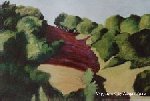Introduction 2008: FAULT LINES
The cover of this issue, a painting by Allegra Printz titled Red Hot Micro Fault,
depicts a California hillside split down the middle by a seam, in which the two sides are ready
to slide into each other and disappear in the earth’s interior. About the inspiration of the
painting, Printz explained that the red hot area is a shadow on the California landscape north
of San Francisco, which changed into a more energetic and slightly menacing presence as the work
developed. The image took shape as a result of a general anxiety she felt after a series of
tremors and jolts, and the painting depicts an imagined fault, even though the particular
landscape may actually be the site of a real fault, which are plentiful throughout California.
I chose this painting just as news of the earthquake in China broke early this summer and the
stories of the destruction dominated the airways for the next few months.
Looking through the poems in the current issue of The Poetry Porch now, I am struck by
the prevalence of images that show how much the weather and environment have been on the minds
of contributors. Diverse influences of speech can overwhelm like storm surges, a hurricane, or
walking under waves (Teresa Iverson). Memories seem most irretrievable when they disappear into
the depths of the water (Marge Piercy). Family relationships can create such a tumult in the
midst of a dream that the cliché weathering the storm becomes storming the weather (Ellen Davis).
While we can be sure that the weather of tomorrow will not be like that of today (Michael
Blumenthal), we can also rest assured that bad news is waiting for us, as likely to come in the
lists of the rising numbers of the dead in Iraq as reports of an advancing frontal systems.
This juxtaposition of unpredictable weather patterns and war deaths that are becoming
routine captures the irony of the times, in which we seem to be in even less control of our
efforts in international diplomacy, not to mention the economy, than we are of our ability to
prepare for the next natural disaster.
In this issue you will find, besides the many poems, an interview with Lloyd Schwartz
about his friendship with Elizabeth Bishop and some reviews of books of poetry. New sonnets on
the Sonnet Scroll show continued interest in the form in its traditional and many hybrid
manifestations. In the words of Matthew Woolven, “I am a poet now. Where do I begin?” his answer
stands in the form of his question: one can begin by creating a sonnet.
Joyce Wilson
August 2008

